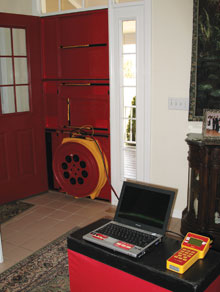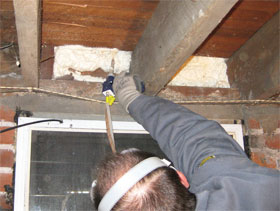In Business Since | License #
In Business Since | License #


A blower door test sucks air out of a
house, drawing in outside air through leakage points.
Dr. Energy Saver technicians know where to look for leaks. But to get a complete picture of how your home leaks and wastes energy, our technicians also use some specialized equipment.
An infiltrometer or blower door fan is typically placed in the main entry doorway to depressurize the house, or suck out air from the interior. This causes outside air to be drawn into the house through all leakage points. As the fan is running, a technician can move from room to room throughout the house to detect and diagnose air leaks.
To have a Dr. Energy Saver contractor perform this test in your home, contact us today! We'll be happy to discuss the details and potential benefits for your home.
Sometimes it's possible to literally see or hear where air is coming into the house. But heatless smoke tools are often used to pinpoint leak locations. Technicians may also use a special camera that's super-sensitive to differences in temperature. Surface temperatures show up in contrasting colors, indicating a possible air leakage point.
In addition to helping the technician detect and diagnose air-leaks all over the house, a blower door test also allows your home's air-leakage rate to be calculated.

Smoke tools help to pinpoint air leak locations in the home.
Your Dr. Energy Saver technician can compare the leakage rate (expressed in cubic feet of air per minute) to the size of the house to see how many air changes per hour (ACH) your house could have due to air leakage.
Blowing smoke is a good thing. Leaks aren't easy to find. Sometimes they're hidden behind molding or cover plates. They can also be covered by insulation. To detect leaks precisely, Dr. Energy Saver performs an infiltrometer or blower door test to suck air out of the house, which draws outside air into the house through leakage points. Smoke tools help to pinpoint leak locations.
With the visual inspection and blower door test complete, you should have a pretty good idea of your how much impact leaks are having on your energy use and comfort. Now what? You're probably wondering: "With so many leaks to plug, where do I start?"
Don't worry. We've got you covered, and we will help you understand air leakage and sealing. Dr. Energy Saver's air-sealing strategy provides a simple, common-sense approach to air sealing your home. It's important to air-seal the attic first (A) because this is where the most significant leakage occurs. Basement (B) and crawl space areas are the second priority. Air-sealing these spaces eliminates a major source of cold air infiltration. With A and B zones taken care of, what remains is the conditioned space (C) or the main living area of your house.
Fiberglass and cellulose insulation will not stop energy-wasting air leaks. Spray foam insulation is the only type of insulation that can also perform effectively as an air sealer. If you are planning energy upgrades that include other types of insulation -like fiberglass or cellulose, for example--make sure that your home has air-sealing work completed first.

No more leaks! Dr. Energy Saver uses two-part
foam for many air-sealing tasks. The mixture starts as a liquid, expands to fill and adhere to gaps and cracks, and cures to create an airtight barrier that also provides good insulation value.
"Now that I've had air sealing done, I can't wait to see how much more energy efficient my house is going to be."
The excitement is understandable. And if you've had air sealing done by a Dr. Energy Saver crew, you won't have to wait for several months worth of utility bills to see a difference in home energy saving. Dr. Energy Saver technicians perform a second blower door test following the completion of air sealing work. The lower leakage rating will confirm that the house is more airtight, ensuring better energy performance, greater levels of comfort and savings on heating and cooling costs.
Looking for a price? Get a no cost, no obligation free estimate.